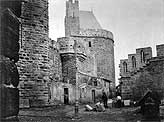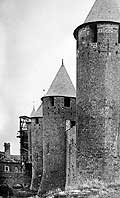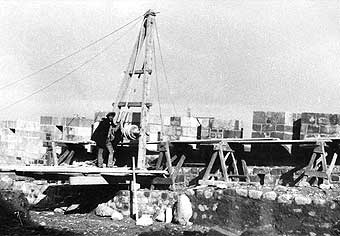 |
 |
|
| Restoration site, Saint-Louis Barbican. Around 1872. |
| THE RESTORATION WORK |
 |
Chronology
of work under Viollet-le-Duc and his successor Paul Boeswillwald |
 |
The
old Saint-Nazaire Saint-Celse Cathedral |
 |
The Narbonne Gate |
 |
The Saint-Nazaire Gate |
 |
The West Fortifications |
 |
The North Fortifications |
 |
The Restoration Site |
 |
After
the Death of Viollet-le-Duc : Paul Boeswillwald |
| Hoisting engine and scaffolding on the east curtain wall of the castle, 1909 (detail). | |
 |

 he
work which was interrupted during the winter, was supervised
on site by Guiraud Cals from Carcassonne, Viollet-le-Duc's assistant
and the project inspector. The responsibility for the restoration
work rested effectively on his shoulders. The architect came
to Carcassonne once a year, usually in June or July, gave his
orders and, when he left, gave enough details for the work in
progress while other questions were dealt with in correspondence
between the inspector and the Parisian architect. The work was
put in the hands of local companies such as that of Jean Magné,
as well as to specialised artists: sculptors and stone-cutters
(Nelli, Perrin, Sage, Dubois…), blacksmiths, master glassworkers
(Fourniol, Cambey). The blocks of sandstone for the restoration
of the ramparts and towers were taken from local quarries while
the slate for the roofs came from the Montagne Noire.
he
work which was interrupted during the winter, was supervised
on site by Guiraud Cals from Carcassonne, Viollet-le-Duc's assistant
and the project inspector. The responsibility for the restoration
work rested effectively on his shoulders. The architect came
to Carcassonne once a year, usually in June or July, gave his
orders and, when he left, gave enough details for the work in
progress while other questions were dealt with in correspondence
between the inspector and the Parisian architect. The work was
put in the hands of local companies such as that of Jean Magné,
as well as to specialised artists: sculptors and stone-cutters
(Nelli, Perrin, Sage, Dubois…), blacksmiths, master glassworkers
(Fourniol, Cambey). The blocks of sandstone for the restoration
of the ramparts and towers were taken from local quarries while
the slate for the roofs came from the Montagne Noire.







